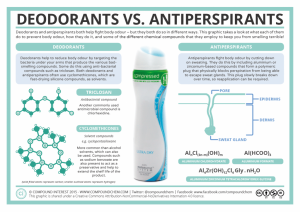Behind these claims: Deodorants vs. Antiperspirants which Chemistry via Coumpound Interest
23 September 2015
Deodorants and antiperspirants are products that the majority of us make use of everyday. The two terms aren’t interchangeable, however; there is a difference in the manner in which they act to reduce body odour. Today’s graphic is a collaboration with ACS Reactions looking at the chemical compounds that allow each to do their job; check out the ACS Reactions video here, then read on below for a more detailed look at some of the health discussions surrounding the chemical entities found in these products.
The primary difference between deodorants and antiperspirants is the manner in which they reduce body odour. Body odour itself is the consequence of the bacteria living in our underarms, who produce a range of compounds likened variously to the smells of onion, cumin, and goat (yes, goat). Deodorants tackle the odour by targeting the bacteria. To do this, they contain antibacterial compounds, such as triclosan and chlorhexidine.
Triclosan, in particular, is a compound that’s come under scrutiny in recent years. The FDA don’t class it as a compound that’s hazardous to humans, but they also note that a number of studies have been published since their last review of the ingredient that warrant further attention. Some animal studies have suggested that triclosan could alter hormone regulation, though results in animal studies don’t always guarantee the same results will be seen in humans. Additionally, there are concerns that the use of triclosan could contribute to bacterial resistance to antibiotics.








 Follow us on Linkedin!
Follow us on Linkedin!
You must be logged in to post a comment.